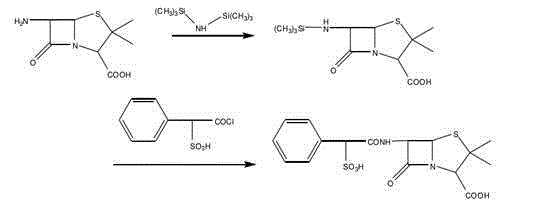Process for preparing sulbenicillin sodium by using enzymic method
A technology for the preparation of sulbenicillin sodium and enzymatic method, which is applied in the field of enzymatic preparation of sulbenicillin sodium, can solve the problems of high industrial control requirements, high toxicity to operators, cumbersome synthesis process, etc., and achieve environmental pressure relief and safety The effect of high and simplified process
- Summary
- Abstract
- Description
- Claims
- Application Information
AI Technical Summary
Problems solved by technology
Method used
Image
Examples
Embodiment 1
[0034] An enzymatic process for preparing sulfbenicillin sodium includes the following steps:
[0035] (1) Add 100L of 10% penicillin fermentation broth to a reactor equipped with 2000KU penicillin acylase, adjust the pH of the solution to about 8.3 with 5% ammonia water, set the temperature to 35°C, and stir at 750 rpm. During the reaction, the content of penicillin is detected. When the conversion rate of penicillin is ≥95%, pass the resulting mixture through the screen at the bottom of the reactor to trap penicillin acylase and other macromolecular substances;
[0036] (2) Pass the mixed solution obtained in step (1) through an ultrafilter with a molecular weight cut-off of 3000-5000 Dalton and a nanofilter with a molecular weight cut-off of 100-200 Dalton to obtain a concentrated solution;
[0037] (3) Decolorize the concentrated solution obtained in step (2) with activated carbon. The amount of activated carbon added is 2.5‰, and the phenylacetic acid is adsorbed and se...
Embodiment 2
[0041] An enzymatic process for preparing sulfbenicillin sodium includes the following steps:
[0042] (1) Add 100L of 10% penicillin fermentation broth to the reactor equipped with 2000KU penicillin acylase, adjust the pH of the solution to about 7.8 with 5% ammonia water, set the temperature to 25°C, and stir at 600 rpm. During the reaction, the content of penicillin is detected. When the conversion rate of penicillin is ≥95%, pass the resulting mixture through the screen at the bottom of the reactor to trap penicillin acylase and other macromolecular substances;
[0043] (2) Pass the mixed solution obtained in step (1) through an ultrafilter with a molecular weight cut-off of 3000-5000 Dalton and a nanofilter with a molecular weight cut-off of 100-200 Dalton to obtain a concentrated solution;
[0044] (3) Decolorize the concentrated solution obtained in step (2) with activated carbon. The added amount of activated carbon is 5‰, and the phenylacetic acid is adsorbed and se...
Embodiment 3
[0048] An enzymatic process for preparing sulfbenicillin sodium includes the following steps:
[0049] (1) Add 10% penicillin fermentation broth to a reactor equipped with 2000KU penicillin acylase, adjust the pH of the solution to about 8.5 with 5% ammonia, set the temperature to 28°C, and stir at 700 revolutions per minute. During the process, the content of penicillin is detected. When the conversion rate of penicillin is ≥95%, the resulting mixture is passed through the screen at the bottom of the reactor to trap penicillin acylase and other macromolecular substances;
[0050] (2) Pass the mixed solution obtained in step (1) through an ultrafilter with a molecular weight cut-off of 3000-5000 Dalton and a nanofilter with a molecular weight cut-off of 100-200 Dalton to obtain a concentrated solution;
[0051] (3) Decolorize the concentrated solution obtained in step (2) with activated carbon. The amount of activated carbon added is 6‰, and the phenylacetic acid is adsorbed...
PUM
 Login to View More
Login to View More Abstract
Description
Claims
Application Information
 Login to View More
Login to View More - Generate Ideas
- Intellectual Property
- Life Sciences
- Materials
- Tech Scout
- Unparalleled Data Quality
- Higher Quality Content
- 60% Fewer Hallucinations
Browse by: Latest US Patents, China's latest patents, Technical Efficacy Thesaurus, Application Domain, Technology Topic, Popular Technical Reports.
© 2025 PatSnap. All rights reserved.Legal|Privacy policy|Modern Slavery Act Transparency Statement|Sitemap|About US| Contact US: help@patsnap.com



